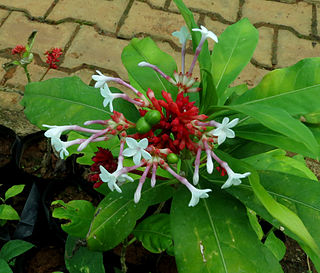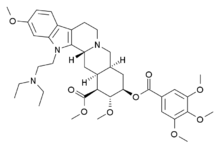ATC code C02Antihypertensives is a therapeutic subgroup of the Anatomical Therapeutic Chemical Classification System, a system of alphanumeric codes developed by the World Health Organization (WHO) for the classification of drugs and other medical products. Subgroup C02 is part of the anatomical group C Cardiovascular system.

Reserpine is a drug that is used for the treatment of high blood pressure, usually in combination with a thiazide diuretic or vasodilator. Large clinical trials have shown that combined treatment with reserpine plus a thiazide diuretic reduces mortality of people with hypertension. Although the use of reserpine as a solo drug has declined since it was first approved by the FDA in 1955, the combined use of reserpine and a thiazide diuretic or vasodilator is still recommended in patients who do not achieve adequate lowering of blood pressure with first-line drug treatment alone. The reserpine-hydrochlorothiazide combo pill was the 17th most commonly prescribed of the 43 combination antihypertensive pills available In 2012.

Fluacizine, sold under the brand name Phtorazisin, is a tricyclic antidepressant (TCA) of the phenothiazine group which is or was marketed in Russia. Unlike other phenothiazines, fluacizine is not an antipsychotic, and can actually reverse catalepsy and extrapyramidal symptoms induced by antidopaminergic agents like antipsychotics, reserpine, and tetrabenazine as well as potentiate amphetamine-induced stereotypy. It is known to act as a norepinephrine reuptake inhibitor, antihistamine, and anticholinergic. The drug was developed in the 1960s and was marketed in the 1970s. It is the trifluoromethyl analogue of chloracizine.

Rauvolfia serpentina, the Indian snakeroot, devil pepper, or serpentine wood, is a species of flower in the milkweed family Apocynaceae. It is native to the Indian subcontinent and East Asia.

The solute carrier family 18 member 2 (SLC18A2) also known as vesicular monoamine transporter 2 (VMAT2) is a protein that in humans is encoded by the SLC18A2 gene. SLC18A2 is an integral membrane protein that transports monoamines—particularly neurotransmitters such as dopamine, norepinephrine, serotonin, and histamine—from cellular cytosol into synaptic vesicles. In nigrostriatal pathway and mesolimbic pathway dopamine-releasing neurons, SLC18A2 function is also necessary for the vesicular release of the neurotransmitter GABA.

Prenylamine (Segontin) is a calcium channel blocker of the amphetamine chemical class that was used as a vasodilator in the treatment of angina pectoris.

Oxypertine is an antipsychotic used in the treatment of schizophrenia. It was also evaluated for the treatment of anxiety at a dosage of 20 mg per day. Chemically, it is an indole and phenylpiperazine derivative. Like reserpine and tetrabenazine, oxypertine depletes catecholamines, though not serotonin, possibly underlying its neuroleptic efficacy. Its structure is similar to solypertine and milipertine.

Tametraline (CP-24,441) is the parent of a series of chemical compounds investigated at Pfizer that eventually led to the development of sertraline (CP-51,974-1).

Methoserpidine is an antihypertensive drug related to reserpine.

Deserpidine (INN) or reserpidine (USAN) is an antihypertensive drug structurally related to reserpine which occurs naturally in Rauvolfia spp.

Talsupram is a selective norepinephrine reuptake inhibitor (NRI) which was investigated as an antidepressant in the 1960s and 1970s but was never marketed. Along with talopram, it is structurally related to the selective serotonin reuptake inhibitor (SSRI) citalopram.

Rauvolfia vomitoria, the poison devil's-pepper, is a plant species in the genus Rauvolfia. It is native from Senegal east to Sudan and Tanzania, south to Angola; and naturalized in China, Bangladesh, different ranges of Himalayan and Puerto Rico. The plant contains a number of compounds of interest to the pharmaceutical industry and is widely used in traditional medicine.

Alseroxylon is a norepinephrine reuptake inhibitor that has been investigated in the treatment of hypertension and angina pectoris and as a sedative in psychoses. It was at one time approved for use in the United States, but has since been discontinued.
Rustom Jal Vakil was a cardiologist from India who was awarded a Padma Bhushan for his contributions to medicine. He was the first Indian to win a Lasker Award.

Alstonine is an indoloquinolizidine alkaloid and putative antipsychotic constituent of various plant species including Alstonia boonei, Catharanthus roseus, Picralima nitida, Rauwolfia caffra and Rauwolfia vomitoria. In preclinical studies alstonine attenuates MK-801-induced hyperlocomotion, working memory deficit and social withdrawal. It also possesses anxiolytic-like effects in preclinical studies, attenuates amphetamine-induced lethality and stereotypy as well as apomorphine-induced stereotypy, and attenuates haloperidol-induced catalepsy. These effects appear to be mediated by stimulation of the 5-HT2C receptor. In addition, alstonine, similarly to clozapine, indirectly inhibits the reuptake of glutamate in hippocampal slices. Unlike clozapine however, the effect of which is abolished by the D2 receptor agonist apomorphine, alstonine requires 5-HT2A and 5-HT2C receptors to produce this effect, as it is abolished by antagonists of these receptors. Also unlike clozapine, alstonine lacks pro-convulsant activity in mice.

GBR-13119 is a psychostimulant and dopamine re-uptake inhibitor.

Perafensine (INN) is a drug which was investigated as an antidepressant but was never marketed. It has been reported to antagonize the effects of reserpine and to inhibit the reuptake of norepinephrine ; whether it also affects the reuptake of serotonin or dopamine is unclear.

Estradiol butyrylacetate (EBA), sold under the brand names Follikosid and Klimanosid-R Depot, is an estrogen medication which is no longer marketed. It is an estrogen ester, specifically, an ester of estradiol. It is administered by intramuscular injection and a single 10 mg dose has been said to have a duration of action of 2 to 3 weeks. The excretion of EBA in women has been studied.

Syrosingopine is a drug, derived from reserpine. It is used to treat hypertension.

Estradiol butyrylacetate/testosterone ketolaurate/reserpine (EBA/TKL/R), sold under the brand name Klimanosid R-Depot, is an injectable combination medication of estradiol butyrylacetate (EBA), an estrogen, testosterone ketolaurate, an androgen/anabolic steroid, and reserpine, an antipsychotic, which was previously used in menopausal hormone therapy for women, particularly in those with pronounced neurovegetative symptoms. It contains 2 mg EBA, 50 mg TKL, and 0.4 mg reserpine in oil solution in each 1 mL ampoule and is administered by intramuscular injection at regular intervals. The medication was marketed in 1957.
















